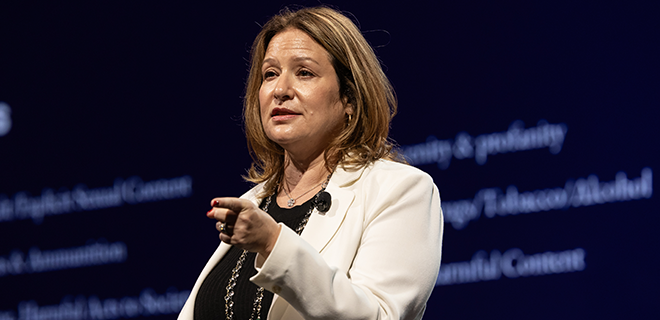
Advertisers miss out on reaching engaged, high-value audiences by fearing news content. The Washington Post’s Jana Meron explains why it’s time to rethink brand safety in news advertising.
Are advertisers afraid of the news? That’s the question Jana Meron, VP of Revenue Operations and Data at The Washington Post, asked at Programmatic IO.
For many brands, the answer seems to be a resounding “yes,” especially during politically charged election cycles. But Meron had a different take. She argued that this fear-driven approach is outdated and costs advertisers big opportunities.
Just a few months earlier, she spoke to publishers at AdMonsters Publisher Forum in Boston, focusing on how publishers can balance brand safety with revenue using smarter, more nuanced solutions that respect journalistic integrity.
Both advertisers and publishers should rethink what it means to be “brand safe” in the fast-evolving news world. So what lessons did we learn from Meron about why it’s high time to move beyond fear?
A Tale of Two Audiences: Advertisers and Publishers
At Programmatic IO, Meron talked directly to advertisers, addressing their fears of placing ads near news content, especially political coverage. Armed with data, she made a compelling case for why this fear is misguided.
For instance, she revealed that ads next to political and opinion pieces on The Washington Post see a 55% higher click-through rate than other parts of the site. That’s right—people are paying attention, and these are the valuable, engaged audiences that brands dream of reaching.
At AdMonsters Publisher Forum, Meron spoke to publishers about how they can proactively address brand safety concerns without sacrificing high-quality news content. She explained how The Washington Post uses AI and machine learning to analyze context, sentiment, and risk level of news content — creating a nuanced taxonomy allowing advertisers to set their omfort levels.
This move away from the old “sledgehammer” approach, towards a data-driven strategy, opens up more ad inventory without sacrificing journalistic integrity.
Why Are Advertisers Still Afraid?
Let’s get into the numbers. According to the 2024 Madison and Wall Ad Spend Forecast, 83% of US marketing executives expressed concern about advertising during elections. In fact, some advertisers blocked more than 40% of WaPo’s inventory this year to avoid “risky” content. This, Meron argues, is a shortsighted move.
The Washington Post reaches 10.9 million election-specific readers, 43% of whom are retail investors and many are decision-makers. These news consumers — particularly those engaging with political content — are some of the most valuable readers out there. These aren’t casual readers; they’re engaged, informed, and don’t mind ads.
The Brand Safety Double Standard
So, what’s the problem? Meron says it’s the old-school brand safety rules treating all news content the same way. The brand safety tools that once acted as a necessary shield against fraudulent or harmful content have morphed into blunt instruments, blocking swathes of legitimate news inventory.
The fear is that ads appearing next to controversial topics will hurt the brand’s image. But Meron pointed out that these worries don’t hold up. Most news consumers understand that ads don’t endorse the story next to them. In fact, they often see brands in news as more trustworthy.
Meron calls for a smarter approach. Instead of broad keyword blocklists, we need tech that can differentiate between high, medium, and low-risk content. The Washington Post uses AI to do just that, unlocking 15-25% more ad reach for advertisers. It’s proof that you don’t need to sacrifice quality for safety.
Tech Has the Answers—If We Use It Right
What’s the big takeaway from both of Meron’s talks? The tech is here to help us handle brand safety better. AI and machine learning can understand the context of news, including sentiment and bias. That means we can stop treating all news as risky and start making more informed choices.
“The fear that news is too risky is understandable but doesn’t make sense,” she said at Programmatic IO, emphasizing that modern tech can identify sentiment, bias, and context in ways that past tools could not.
At AdMonsters Publisher Forum, she pushed publishers to educate advertisers on this new reality. “It’s not the year of mobile or whatever,” she said. “It’s time to actually do something.” Publishers can use these tools to show advertisers that news content isn’t something to fear — it’s an opportunity.
Facing the Fear: Time to Rethink Brand Safety
It’s time for both advertisers and publishers to face facts and stop letting fear dictate brand safety strategies. Meron made it clear: advertisers are missing out by avoiding news content. Ads next to quality journalism have higher engagement and reach valuable audiences. Meanwhile, publishers should embrace advanced tools to offer nuanced brand safety solutions that align with their content’s integrity.
News Is Good News for Your Business
Brand safety in 2024 doesn’t mean avoiding news and risk entirely — it’s about understanding, navigating, and harnessing it to capture highly engaged, valuable audiences. And, publishers, for their part, must continue to advocate for smarter, more nuanced brand safety measures that respect the integrity of news.
The tools and strategies are there; it’s time for the industry to use them. The audience is waiting. As Meron said, “News is good news for your business.” The sooner we face the facts and acknowledge that, the better off the entire ad tech ecosystem will be.